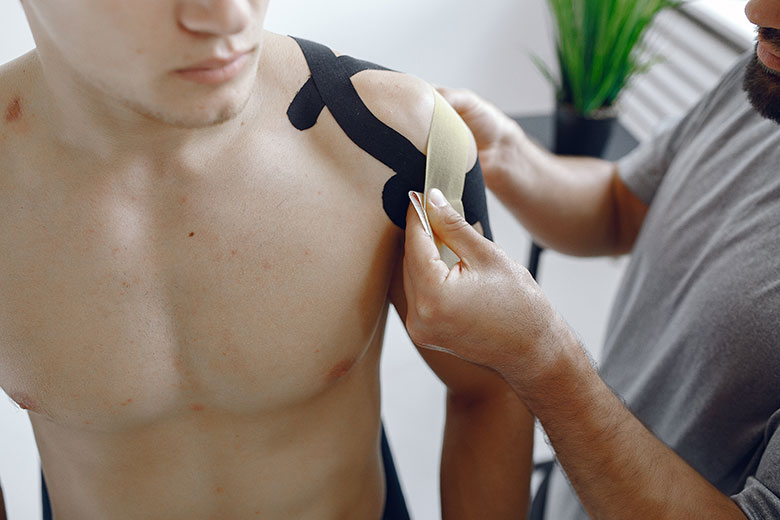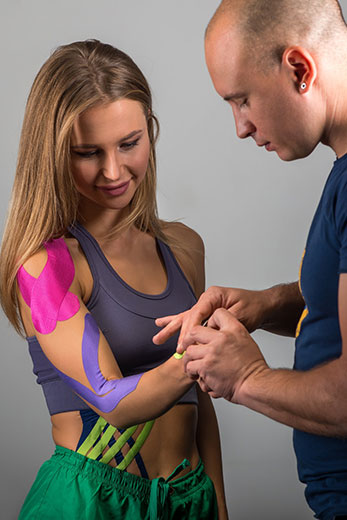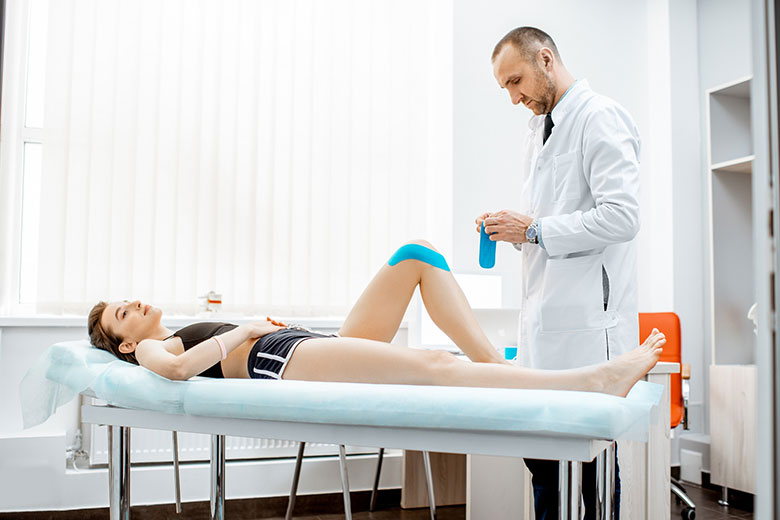Kinesio Taping

Aims of Taping
Tape may be used to: Stabilize or support an injury Relieve pain by de-loading vulnerable or painful structures Facilitate normal movement, muscle action, or postural patterns.
Kinesio Taping–Physiopedia
Kinesio Taping Method is a therapeutic tool utilized by rehabilitation specialists in all programs pediatric, geriatric, orthopedic, neurological, oncology and others. The idea of using elastic tape to mimic the therapist’s hands was first presented by Dr Kenzo Kase in the 1970s. Since then, it became the modality used in pain management, soft tissue injury], tissues and joints malalignment, edema, and more. Kinesio Taping Method utilizes four types of Kinesio Tex Tapes, each with specific properties designed for use on fragile, sensitive skin or applied with higher tensions.
Intended Purpose and Effect of Taping Techniques
The tape is commonly used by physiotherapists to: relieve your pain improve joint stability enhance athlete confidence reduce injury recurrence prevent injury reduce strain on injured or vulnerable tissues correct faulty biomechanics inhibit muscle action facilitate muscle action enhance proprioception compress in the presence of edema or lymphatic drainage.
Some of these purposes may be achieved through a combination of these possible effects of taping: mechanical effects neuromuscular effects psychological effects There are different kinds of tape that can be employed: Rigid strapping tape commonly used in taping or strapping is often referred to as “sports tape” or “athletic tape” and is most often a rigid style of strapping tape. Elastic strapping tape can also be used when less rigidity or support is required. Kinesiology tape is an improved version of elastic sports tape that acts to dynamically assist your muscle function.
Properties
The tape is commonly used by physiotherapists to: relieve your pain improve joint stability enhance athlete confidence reduce injury recurrence prevent injury reduce strain on injured or vulnerable tissues correct faulty biomechanics inhibit muscle action facilitate muscle action enhance proprioception compress in the presence of edema or lymphatic drainage.
Some of these purposes may be achieved through a combination of these possible effects of taping: mechanical effects neuromuscular effects psychological effects There are different kinds of tape that can be employed: Rigid strapping tape commonly used in taping or strapping is often referred to as “sports tape” or “athletic tape” and is most often a rigid style of strapping tape. Elastic strapping tape can also be used when less rigidity or support is required. Kinesiology tape is an improved version of elastic sports tape that acts to dynamically assist your muscle function.
If you want to know what it costs – and what availability we have, then please just click the button below and complete the short form.


Skin: Kinesio Tex Tape applied on the skin with a low degree of stretch changes the density and the concentration of the tissue in the dermis and epidermis. This mechanical stimulus converted into electrical impulses is called mechanotransduction and can produce cell movement. Kinesio Tex Tape produces pressure and stretch on the skin that may be able to stimulate mechanoreceptors. This stimulus interacts with the brain and spinal cord and modulates pain responses.
Lymphatic and Circulatory System: the application of Kinesio Tex Tape facilitates the opening of microvalves due to a dynamic pressure variation due to alteration in skin density. This decompression activates lymphatics in the dermis and improves lymphatic flow. The end result is a tissue inflammation and swelling reduction. It is also theorized that lifting the skin detaches filaments that attach the skin to endothelial cells of the lymphatic and capillary beds. This is proposed to create channels that allow lymph to drain, thus reducing swelling and allowing increased blood flow to the area.
Fascia: the application of Kinesio Tex Tape changes the tension elements in tissues to encourage homeostasis. The tension imposed from the tape frees the fascia of any movement limitations through the movement of the skin relative to the target tissue.
Contra-indications:
- Cancer
- Infection, cellulitis
- Open wound
- DVT
- Previous allergic reaction to Kinesio Tex Tape
General precautions are:
- Diabetes
- Congestive heart failure (CHF)
- Patient receiving dialysis/Kidney disease
- Organ transplants
- Pregnancy
If you’re not quite ready to book an appointment yet and have some questions you would like answered first, click the link below to complete a form to get the conversation started.
Kinesio Taping Method has evolved over the past 20 years from a mechanical effect on the tissue to the neurophysiological one based on the discoveries in cell biology, fascia and mechanotransduction. The Kinesiology taping principles remained unchanged. Research is conducted on healthy subjects when the primary effect of the Kinesio Taping Method is to facilitate tissue return to homeostasis. Kinesio Taping is a method to assist with musculoskeletal system damage.
What does the evidence support?
- Increase ROM
- Improve Function
- Decrease Oedema / Swelling
- Decrease Pain
- Improvement in Quality of Life (QL)
Pros
- Some evidence proves theories
- Provides an optional modality for treatment
- Applicable to multiple patient populations at various stages of rehabilitation
- Decrease in pain encourages movement
- Patient can be taught self-application techniques
Cons
- Inconsistent body of evidence to prove theories
- Can be expensive when used for a prolonged period of time
- Can cause skin irritation or allergic reaction to tape
- Plus logo
- 600+ accredited online courses for clinicians
- Join the world’s largest community of rehabilitation professionals
Are you unsure if physical therapy is right for you? Would you prefer to talk with a PT before making a decision? All you have to do is click the link below to fill out a simple form.
** Note: there is no treatment given at one of our taster sessions. It’s for you to ask us more questions and for us to confirm whether or not we think we can help you.
